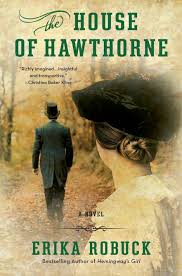The House of Hawthorne: A Novel
- By Erika Robuck
- NAL
- 416 pp.
- Reviewed by Rachael Guadagni
- June 10, 2015
A gentle weaving together of the life, love, and talent of a renowned American novelist and his wife.

Historical fiction delights in no small part because, though the tale is based on real people and events, the author is free to cloak the story in his or her own aesthetic. Research should be meticulous and facts respected, of course, but the narrative can glide, sail, or tumble down the literary path any way the writer sees fit. In Erika Robuck’s The House of Hawthorne, that course is a gentle tour through the life and love of Nathaniel and Sophia Hawthorne.
Written from Sophia’s perspective, Hawthorne introduces the reader to Nathaniel via a lover’s eyes and creates an endearing character separate from the legend, separate from his work. Robuck does a superb job of building Hawthorne from the ground up, weaving the intellect, attitude, and passion of Sophia and her talented-yet-tortured husband together as a singular experience. Married readers will easily identify with the subtle cues and nuanced connections these spouses share, and all will enjoy Robuck’s complex and emotive Sophia, from whom Nathaniel draws his strength.
The story begins near the end of Hawthorne’s life with Sophia establishing the dynamic of her relationship with Nathaniel. Robuck’s heroine is a master at assessing her husband’s physical and emotional state and her descriptions immediately inspire sympathy and concern. Sophia’s thoughts then wander back in time to the moment a young woman with a talent for painting and plagued with debilitating headaches stumbles into the life of a shy, gifted writer. It is here that Robuck begins her portrayal of Sophia; feminist but desirous of married life, traditional but unwilling to fully compromise her independent thought and willfulness. The House of Hawthorne is, in fact, Sophia’s story.
From the beginning, Sophia’s life seems to “jump the tracks,” careening in one direction and then another. Her mother encourages her painting; because of both Sophia’s health issues and an understanding of the toll marriage and motherhood would take on her art, she strongly suggests she avoid both those traditional paths. In hopes of bolstering her health, she and her sister Mary travel to Cuba and stay with family friends.
Encounters with the horrors of slavery and a handsome, dark-eyed young man thrust Sophia into womanhood. Robuck’s young woman is contemplative as she grapples with her ideology and burgeoning emotions, and when she returns to the States she is set to cross paths with Hawthorne, sparking an electric connection.
Robuck has several emotional plates spinning as she ignites the relationship between the protagonists, sets up conflict between Sophia, her sisters, and other characters, and keeps tragedy always at the ready. The marriage begins, loved ones perish, and Nathaniel battles his demons while producing some of the most beloved works of literary history.
Robuck accomplishes this masterful mix by applying the most quintessential of all concepts: simplicity. At its heart, the story is merely a life narrative told by a compelling woman. But it is here that Robuck’s method proves its worth. She allows the genius of Nathaniel Hawthorne to emerge unencumbered by literary fawning, and she channels the strength and artistic soul of Sophia into expression as a devoted wife and mother. Robuck keeps the “house of Hawthorne” familiar and accessible to everyone.
The driving force behind Hawthorne is language. At times, the rolling prose moves from why-don’t-we-still-talk-like-this to pleasantly sweet to saccharin, but never so much of any that the reader disengages from the story. Robuck weaves her setting out of Old World expression. Similarly, the characters express themselves in ways that are direct, powerful, and poetic. She is constantly moving them from assuredness to exasperation, peace to turmoil.
As the book and Nathaniel’s life near their end, the reader cannot help but feel that maybe things won’t end as one knows they will. Perhaps there will be a moment of clarity, a flash of self-actualization that will bring emotional harmony and make it all worthwhile. Alas, the angst and struggle that defined the Hawthornes' life continue to the end.
But here, again, Robuck remains true to her style and leaves us satisfied with the simple but determined words of her heroine: “And in our story, the romance of the Hawthornes, I will have the final word.”
Rachael Guadagni is a writer based in Lexington, Kentucky. Her work has appeared in Kentucky Monthly, Maryland Life, Her Mind, and other publications.

_80_121.png)